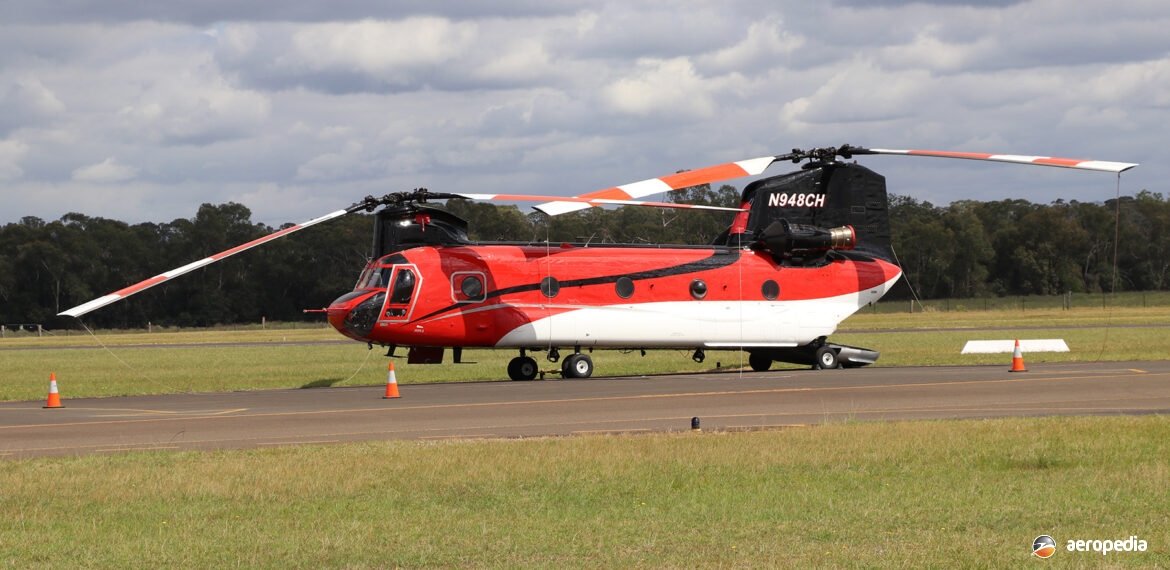Photograph:
Boeing 234 N948CH (c/n M.3354) at Camden, NSW in November 2017 (David C Eyre)
Country of origin:
United States of America
Description:
Heavy lift twin-engine helicopter
Power Plant:
Two 3,039 kw (4,075 shp) Avco Lycoming AL 5512 turboshafts
Specifications:
- Rotor diameter [each]: 18.29 m (60 ft)
- Length overall rotors turning: 30.18 m (99 ft)
- Height: 5.68 m (18 ft 8 in)
- Rotor disc area [total]: 525.34 m² (5,655 sq ft)
- Max speed at sea level: 269 km/h (167 mph)
- Economical cruising speed: 254 km/h (158 mph)
- Service ceiling: 4,570 m (15,000 ft)
- Max range with 44 passengers and 45 mins reserve: 1,009 km (627 miles)
- Empty weight: 11,090 kg (24,449 lb)
- Max take-off weight with internal load: 21,319 kg (47,000 lb)
- Max take-off weight with external load: 23,133 kg (51,000 lb)
History:
In 1956 Boeing Vertol commenced the development of an all-weather medium transport helicopter for the US Army, this eventually entering service as the CH-47. In 1978 the Company announced the development of a civil variant for commercial service, two variants being proposed, a long-range model known as the Model 234LR to operate in an all-passenger, passenger freight combi, or all cargo civil role. The other variant was the Model 234UT being a utility variant for tasks such as resource exploration, logging and construction work.
The program was launched in November 1978 after a contract was received from British Airways Helicopters for three machines to carry passengers and priority cargo from points in Scotland to North Sea oil platforms. The helicopter had two three-blade rotors rotating in opposite directions, being driven by Lycoming AL 5512 turboshafts driving through a combined gearbox with interconnecting drive shafts which enabled both rotors to be driven by one engine in an emergency.
The prototype Model 234LR was first flown on 19 August 1980, the test program for CAA and FAA certification continuing that year with the machine entering service in 1981. First Model 234UT was for Asahi Helicopters operating from Tokyo in Japan and it had optional tankage in the sponsons.
The Chinook, as the Boeing 234 became known on the civil market, also sold in small numbers to commercial operators for heavy-lift, logging, construction, fighting forest fighting and supporting petroleum exploration operations. A civil variant of the CH-47C had a strengthened transmission, AlliedSignal T55-L-11C engines of 2,800 kw (3,750 hp) and an increased range. Changes from the military variants included the use of fibreglass rotor blades of larger chord, changed fairings along the sides of the fuselage for fuel, a longer nose to house weather radar, and the nose undercarriage shifted forward.
Two variants have been available, one with a 6,360 kg (14,021 lb) fuel capacity, and the other, a utility variant, which had fuel tanks to a capacity of 1,826 kg (4,026 lb) contained in four small fairings level with each undercarriage wheel. In passenger configuration it could, in the long-range model, seat 44 in four rows with a central corridor.
First orders for the civil variant were from British Airways Helicopters, which ordered six for offshore work in the North Sea, followed by Helicopter Service of Norway and ARCO of Alaska for similar work. Some 13 were delivered, and three went to the Taiwan Army, later being transferred to the Taiwan Forest Service, most ending up with Colombia Helicopters in Canada.
One example of the Model 234UT, owned by Colombia Helicopters, arrived in Brisbane, QLD at Eagle Farm on 1 April 2006 after being unloaded at the Fishermans Island docks upon arriving from the United States and, the following day, 2 April, left on its delivery flight as P2-CHJ (c/n MJ-002 – ex LN-OMA, N245CH) for Papua New Guinea via Cairns, QLD and entered service.
Other Model 234UTs have been operated by Colombia Helicopters in New Guinea on heavy-lift work, alongside at least five Boeing Vertol 107-IIs. Boeing 234s in New Guinea have included P2-CHI (c/n MJ-003 ex G-BISR, N237CH), P2-CHJ (c/n MJ022), P2-CHK (c/n MJ-006 – ex C-FHFJ, C-GHFP, G-BISP, N239CH), P2-CHL (c/n MJ017) and P2-CHY (c/n MJ-005 ex C-FHFB, G-BISN, N238CH).
In December 2016 Boeing Vertol 234 N238CH (c/n MJ-005 – ex C-FHFB, CGHFP, G-BISN) was flown from docks in Melbourne, VIC to New Guinea to commence work in the southern highlands. It later became P2-CHY and for a period operated in the Sydney area, NSW on fire- bombing operations during the 2019-2020 bushfire season.

